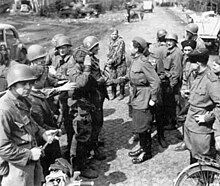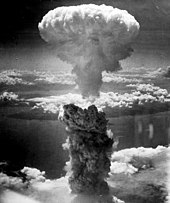On 16 December 1944, Germany attempted its last desperate measure for success on the Western Front by marshalling German reserves to launch a massive counter-offensive in the Ardennes to attempt to split the Western Allies, encircle large portions of Western Allied troops and capture their primary supply port at Antwerp in order to prompt a political settlement. By January, the offensive had been repulsed with no strategic objectives fulfilled. In Italy, the Western Allies remained stalemated at the German defensive line. In mid-January 1945, the Soviets attacked in Poland, pushing from the Vistula to the Oder river in Germany, and overran East Prussia. On 4 February, U.S., British, and Soviet leaders met in Yalta. They agreed on the occupation of post-war Germany, and when the Soviet Union would join the war against Japan.
In February, the Soviets invaded Silesia and Pomerania, while Western Allied forces entered Western Germany and closed to the Rhine river. In March, the Western Allies crossed the Rhine north and south of the Ruhr, encircling a large number of German troops, while the Soviets advanced to Vienna. In early April, the Western Allies finally pushed forward in Italy and swept across Western Germany, while Soviet forces stormed Berlin in late April; the two forces linked up on Elbe river on 25 April. On 30 April 1945, the Reichstag was captured, signalling the military defeat of Third Reich.
Several changes in leadership occurred during this period. On 12 April, U.S. President Roosevelt died and was succeeded byHarry Truman. Benito Mussolini was killed by Italian partisans on 28 April. Two days later, Hitler committed suicide, and was succeeded by Grand Admiral Karl Dönitz.
German forces surrendered in Italy on 29 April and in Western Europe on 7 May. On the Eastern Front, Germany surrendered to the Soviets on 8 May. A German Army Group Centre resisted in Prague until 11 May.
In the Pacific theatre, American forces accompanied by the forces of the Philippine Commonwealth advanced in the Philippines, clearing Leyte by the end of April 1945. They landed on Luzon in January 1945 and seized Manila in March, leaving it in ruins. Fighting continued on Luzon, Mindanao and other islands of the Philippines until the end of the war.
In May 1945, Australian troops landed on Borneo, overrunning the oilfields there. British, American and Chinese forces defeated the Japanese in northern Burma in March, and the British pushed on to reach Rangoon by 3 May. Chinese forces started to counterattack in Battle of West Hunan that occurred between April 6 and June 7, 1945. American forces also moved towards Japan, taking Iwo Jima by March, and Okinawa by the end of June. American bombers destroyed Japanese cities, and American submarines cut off Japanese imports.
On 11 July, the Allied leaders met in Potsdam, Germany. They confirmed earlier agreements about Germany, and reiterated the demand for unconditional surrender of all Japanese forces by Japan, specifically stating that "the alternative for Japan is prompt and utter destruction". During this conference the United Kingdom held its general election, and Clement Attlee replaced Churchill as Prime Minister. When Japan continued to ignore the Potsdam terms, the United States dropped atomic bombs on the Japanese cities of Hiroshima and Nagasaki in early August. Between the two bombs, the Soviets, pursuant to the Yalta agreement, invaded Japanese-held Manchuria, and quickly defeated the Kwantung Army, which was the primary Japanese fighting force. The Red Army also captured Sakhalin Island and theKuril Islands. On 15 August 1945 Japan surrendered, with the surrender documents finally signed aboard the deck of the American battleship USS Missouri on 2 September 1945, ending the war.



No comments:
Post a Comment